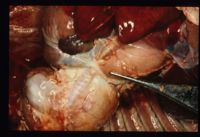Difference between revisions of "Vascular Ring Anomalies"
| Line 108: | Line 108: | ||
==Test yourself with the Developmental Pathology Flashcards== | ==Test yourself with the Developmental Pathology Flashcards== | ||
| − | [[ | + | [[Cardiovascular Developmental Pathology Flashcards]] |
Revision as of 16:01, 15 February 2011
Most commonly found in dogs and cats. Acyanotic; clinical signs due to constriction of the oesophagus:
- Regurgiation of food, usually noticed at weaning.
- Aspiration pneumonia.
Persistent Right Aortic Arch
Most common vascular ring anomaly, increased incidence in GSDs, and Irish setters. vascular ring forms between the ductus arteriosus/ligamentum arteriosum and the persistent right aorta. Megaoesophagus is seen cranial to the constriction.
Other causes include:
Double aortic arch
Anomalous subclavian arteries
Arise form the aortic arch rather than the brachiocephalic artery.
Diagnosis:
- Ventral deviation of the trachea and dilation of the oesophagus on radiology.
- Barium swallow definitive.
Treatment:
- Surgical resection possible.
- Dietary management usually sufficient to control regurgitation.
- Seen most frequently in young animals right after weaning
- Common in dogs
- Very rare in cats
Signalment
- Genetics & Predisposed Breeds: Large breeds make up the majority of cases such as:
Description
- During normal embryonic development there are five pairs of aortic arch arteries (1-6, 5 is absent) that undergo developmental changes necessary to form the major arteries of the head, neck, and upper thorax.
- Malformations of the aortic arch arteries can cause several vascular ring anomalies, but the most commonly seen anomaly is persistent right aortic arch (PRAA). With PRAA, the esophagus and trachea are most often encircled by the left ligamentum arteriosum as they pass over the heart base causing chronic esophageal and tracheal compression.
- When a young animal with PRAA is weaned onto solid food, the esophageal and tracheal compression causes food stasis above the narrowed esophageal foramen leading to megaesophagus. Continued stress on the esophagus in this manner can cause permanent damage. Additionally, aspiration pneumonia and the resulting respiratory distress is a complication of postprandial regurgitation.
Diagnosis
History & Clinical Signs
-Regurgitation (Postprandial=after meals)
-Coughing
-Respiratory distress
-Small size
-Underweight (Malnourished)
-Increased appetite
Physical Exam
-No cardiac murmurs unless PDA is also present
-Palpable dilated cervical esophagus
Radiographic Findings
-Megaesophagus in the thoracic inlet (+/- barium series)
Echocardiographic Findings
Not used to diagnose a PRAA
Electrocardiographic (ECG)
Not used to diagnose a PRAA
Treatment
-Surgical sectioning of the vascular ring anomaly to relieve constriction of the esophagus and trachea
-Management of esophageal damage: frequent feeding of small semi-solid/liquid meals from an elevated position
Prognosis
-Good with surgery
-Less favourable if there is extensive esophageal damage
==from megaoesophagus page:
Vascular rings are congenital abnormalities of the aortic arch system which interfere with oesophageal function. Many vascular anomalies (such as an aberrant right subclavian artery) are clinically silent and up to 20% of dogs and cats may possess such an anomaly. Clinically significant anomalies are found most commonly in large breed dogs, particularly Irish setters and German Shepherd dogs.
The most common clinically significant anomaly is a dextra-aorta or persistent right aortic arch, in which the aorta is formed by the fourth right branchial arch rather than the fourth left arch. In the normal animal, the aorta, pulmonary artery and ductus arteriosus (which connects the former vessels) all lie on the left side of the oesophagus but, when the aorta develops on the right, the ductus arteriosus must pass across the oesophagus to reach the aorta. The oesophagus is then trapped within a ring formed by the aorta (on the right), the main pulmonary artery (on the left), the ductus arteriosus (or ligamentum arteriosum) dorsally and the heart base ventrally. The compression and stricture produced by the vascular ring prevents the passage of solid food beyond the heart base and food accumulates cranial to the obstruction. This results in dilation (megaoesophagus) which is usually confined to the cranial thoracic region but, in chronic cases, may extend along its entire length.
The condition usually becomes apparent at weaning when animals start to eat solid food that cannot pass through the constricted region. Affected animals tend to regurgitate undigested solid food but, if they are presented for treatment before severe dilation occurs, surgical correction of the ring (if possible) should result in a good prognosis.



